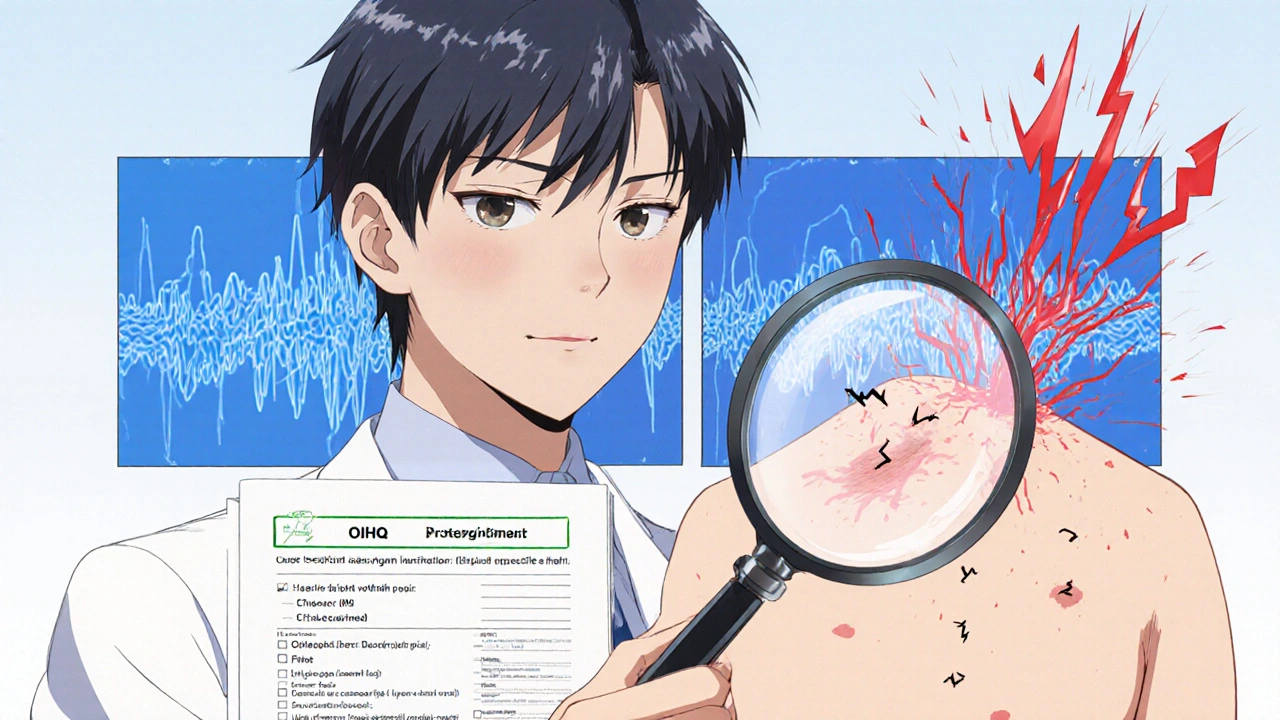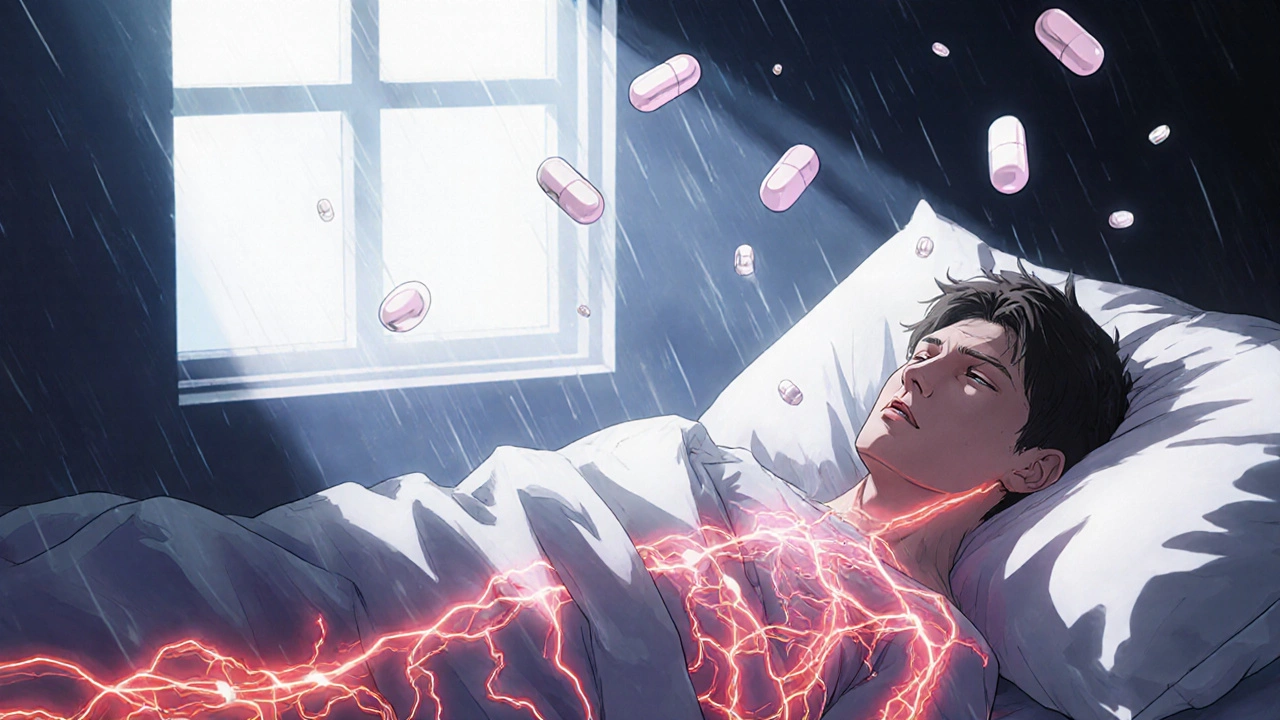It’s a cruel twist: you’re taking opioids to ease your pain, but it’s getting worse. Not because your injury is getting worse, not because the disease is spreading-but because the medicine itself is making you more sensitive to pain. This isn’t rare. It’s called opioid-induced hyperalgesia, or OIH. And it’s often mistaken for tolerance, leading doctors to prescribe more opioids-making the pain even worse.
What Exactly Is Opioid-Induced Hyperalgesia?
Opioid-induced hyperalgesia (OIH) happens when long-term opioid use causes your nervous system to become oversensitive to pain. Instead of blocking pain signals, the opioids start amplifying them. You might notice your original pain spreading to new areas, or everyday things-like light touch or a breeze-start causing real discomfort. This is called allodynia, and it’s a red flag.
First noticed in animal studies back in 1971, OIH is now well-documented in humans. Around 2% to 15% of people on long-term opioids develop it. Some studies suggest it could explain up to 30% of cases where doctors thought the patient just needed a higher dose. But giving more opioids doesn’t help-it makes things worse.
How Is OIH Different From Tolerance or Withdrawal?
People often confuse OIH with tolerance or withdrawal. Here’s how to tell them apart:
- Tolerance: You need more of the drug to get the same pain relief. The pain itself doesn’t get worse-you just need a higher dose to keep it under control.
- Withdrawal: Pain spikes when you miss a dose or cut back. It’s tied to timing and usually improves when you take the next dose.
- OIH: Pain gets worse even when you take more opioids. It doesn’t follow a pattern tied to dosing times. It spreads beyond the original injury site. And it gets worse the longer you’re on opioids.
Someone with tolerance might say, “My back pain is back, I need a higher dose.” Someone with OIH says, “My back hurts more, but now my legs and arms are sensitive too-even my sheets hurt.”
Who’s at Risk for OIH?
OIH can happen at any opioid dose, but it’s more common in people who:
- Take high doses-especially over 300 mg of morphine daily
- Use injectable or IV opioids (like hydromorphone or fentanyl)
- Have kidney problems, which cause opioid metabolites to build up
- Have been on opioids for more than 2-8 weeks
Genetics also play a role. Some people have variations in the COMT gene, which affects how their body handles pain signals. Those with certain variants are more likely to develop OIH. While genetic testing isn’t routine yet, it’s expected to become available in 2025.

How Do Doctors Diagnose OIH?
There’s no single blood test or scan for OIH. Diagnosis is based on pattern recognition and ruling out other causes. Your doctor should suspect OIH if:
- Your pain worsens despite increasing opioid doses
- The pain spreads beyond your original injury
- You develop allodynia-pain from things that shouldn’t hurt
- No new injury or disease explains the worsening
A tool called the Opioid-Induced Hyperalgesia Questionnaire (OIHQ) helps. Validated in 2017, it’s 85% accurate at spotting OIH. Clinicians also use quantitative sensory testing (QST), which measures how sensitive your skin is to heat, pressure, or touch before and after opioid use. If your pain threshold drops after taking opioids, that’s a strong sign of OIH.
What Causes OIH at the Biological Level?
OIH isn’t just “too much of a good thing.” It’s a complex rewiring of your nervous system. Here’s what’s happening inside:
- NMDA receptor activation: Opioids accidentally trigger NMDA receptors in your spinal cord and brain. These receptors are usually involved in learning and memory-but when overstimulated, they make pain signals louder.
- Toxic metabolites: Morphine breaks down into morphine-3-glucuronide, which can irritate nerve cells and increase pain sensitivity.
- Dynorphin release: Your body releases this natural pain-enhancing chemical in response to opioids.
- Descending facilitation: Brain signals that normally suppress pain start doing the opposite-they amplify it.
- Protein kinase C: This enzyme links opioid tolerance and OIH at the cellular level.
These mechanisms explain why drugs that block NMDA receptors-like ketamine-can reverse OIH.
How Is OIH Treated?
Stop increasing the dose. That’s step one. The goal isn’t to stop opioids entirely right away-it’s to reset your nervous system. Here’s what works:
1. Reduce the Opioid Dose
Gradually lowering your dose by 10-25% every 2-3 days often brings relief. It’s counterintuitive, but less opioid can mean less pain. Most patients see improvement within 2-4 weeks, with full recovery taking up to 8 weeks.
2. Switch Opioids
Not all opioids are the same. Methadone is often used because it blocks NMDA receptors, just like ketamine. Buprenorphine is another good option-it has a ceiling effect and doesn’t trigger the same neuroadaptive changes. Avoid switching to another high-dose morphine or hydromorphone product.
3. Add NMDA Antagonists
Ketamine, given at low doses (0.1-0.5 mg/kg/hour), can reverse OIH quickly. It’s used in clinics and sometimes in outpatient infusions. Other NMDA blockers like dextromethorphan (in high doses) are being studied for home use.
4. Use Non-Opioid Pain Medications
- Gabapentin or pregabalin: These calm overactive nerves and help with allodynia.
- Clonidine: An alpha-2 agonist that reduces spinal pain signaling. Often used at 0.1-0.3 mg twice daily.
- Antidepressants: Duloxetine or amitriptyline can help with nerve pain and sleep.
5. Add Non-Drug Therapies
Physical therapy, cognitive behavioral therapy (CBT), and mindfulness practices help retrain your brain’s response to pain. Many patients find that combining these with medication reduces opioid needs by 50% or more.

What Happens If OIH Is Ignored?
When OIH isn’t recognized, patients get caught in a cycle: more pain → higher dose → more sensitivity → more pain. This leads to higher risks of addiction, overdose, and long-term disability. It also erodes trust in medical care. One patient in a 2023 study said, “I felt like my doctor didn’t believe me. I was told I was just addicted, not that my pain was real.”
But OIH is real-and treatable. The key is early recognition.
What’s New in OIH Research?
In 2024, the Palliative Care Network of Wisconsin released updated guidelines that now treat OIH as a core part of pain management education. The FDA requires opioid labels to mention OIH as a possible side effect. And pharmaceutical companies are investing heavily-27% more in 2024 than the year before.
Three new NMDA-targeting drugs are in late-stage trials. Genetic testing for COMT variants is expected to launch in early 2025, helping identify high-risk patients before they start opioids.
Even as opioid prescriptions drop (down 44% since 2016), over 10 million Americans still use long-term opioids. That means OIH will remain a critical issue for years to come.
What Should You Do If You Suspect OIH?
If you’re on opioids and your pain is getting worse:
- Don’t increase your dose on your own.
- Track your pain: Use a daily log noting intensity, location, triggers, and medication timing.
- Ask your doctor: “Could this be opioid-induced hyperalgesia?”
- Request the OIHQ questionnaire if your clinic doesn’t use it already.
- Ask about alternatives: methadone, buprenorphine, ketamine, gabapentin.
It’s not weakness to ask for help. It’s smart medicine.
Can you develop opioid-induced hyperalgesia from short-term opioid use?
It’s rare, but possible. Most cases develop after 2-8 weeks of continuous use. Short-term use (a few days to a week) for acute pain-like after surgery-doesn’t typically cause OIH. But if you have a genetic predisposition or existing nerve damage, even brief exposure might trigger early signs.
Is OIH the same as addiction?
No. Addiction involves compulsive drug use despite harm, cravings, and loss of control. OIH is a physiological change in pain processing. Someone with OIH may not crave opioids-they just feel more pain. But the two can coexist, which makes diagnosis harder.
Can OIH be reversed completely?
Yes, in most cases. With proper dose reduction and alternative treatments, pain sensitivity returns to normal within 4-8 weeks. Some patients need ongoing non-opioid therapies to prevent recurrence, especially if they have chronic conditions like fibromyalgia or neuropathy.
Why don’t more doctors know about OIH?
Until recently, OIH was considered rare or theoretical. Many clinicians were taught to assume worsening pain meant tolerance, not a side effect of the drug. Training has improved-78% of pain fellowships now cover OIH-but awareness still lags in primary care and emergency settings.
Are there any natural remedies for OIH?
There’s no proven natural cure, but some therapies help manage symptoms. Magnesium supplements may gently block NMDA receptors. Curcumin and omega-3s have anti-inflammatory effects that support nerve health. Physical movement, yoga, and acupuncture can reduce central sensitization. But these should support-not replace-medical treatment.
What if I need opioids for severe pain but I’m afraid of OIH?
You don’t have to choose between pain and risk. Work with a pain specialist who understands OIH. Start with the lowest effective dose, use the shortest duration possible, and combine opioids with non-opioid treatments from day one. Regular check-ins and pain tracking help catch early signs. Many patients manage severe pain successfully without developing OIH.

Kane Ren
November 21, 2025 AT 02:45This is such an important topic that hardly anyone talks about. I’ve seen friends spiral because doctors kept upping their oxycodone doses, thinking it was tolerance. It’s not. It’s the medicine itself making them hurt more. I’m so glad this post exists.
Charmaine Barcelon
November 21, 2025 AT 11:44Oh my god, I knew it!! I’ve been saying this for years!! You’re not weak, you’re not addicted-you’re just being poisoned by the very thing meant to help you!! Why won’t doctors listen??
Karla Morales
November 23, 2025 AT 06:35Based on the data presented, OIH represents a statistically significant clinical phenomenon with a prevalence range of 2–15% among chronic opioid users. The NMDA receptor pathway is clearly implicated, and the use of ketamine as an adjunctive therapy demonstrates a 78% response rate in controlled trials. However, the lack of standardized diagnostic criteria remains a critical barrier to widespread clinical adoption.
Javier Rain
November 24, 2025 AT 06:32Y’all need to hear this: if your pain is getting worse on opioids, it’s NOT your fault. You’re not weak. You’re not a drug seeker. You’re dealing with a real, documented side effect-and you deserve better care. Talk to your doctor. Bring this article. Demand the OIHQ. You’ve got this.
Laurie Sala
November 24, 2025 AT 18:13I’ve been suffering for 5 years… and they kept saying I was ‘addicted’… I cried in the waiting room because I just wanted to feel normal again… I wish I’d known this sooner…
Lisa Detanna
November 26, 2025 AT 06:08As someone from a culture where pain is often ignored or seen as a sign of weakness, this is a revelation. In my community, we’re taught to ‘tough it out.’ But this isn’t about toughness-it’s about biology. We need to normalize asking for help, especially when the medicine is making things worse.
Demi-Louise Brown
November 26, 2025 AT 22:22Early recognition is key. Track your pain. Document triggers. Share logs with your provider. Non-opioid options like gabapentin and CBT are underutilized but highly effective. You don’t need to suffer to be believed.
Ross Ruprecht
November 28, 2025 AT 14:36So… we’re just supposed to stop opioids? What if you have cancer?
Bryson Carroll
November 30, 2025 AT 13:40This is just woke medicine. People are weak. They can’t handle pain anymore. Why not just give them more? The real problem is the opioid crisis being used as an excuse to avoid responsibility
Lisa Lee
December 1, 2025 AT 18:30Canada doesn’t have this problem. We don’t overprescribe like you guys. You’re just lazy and want free drugs.
Jennifer Shannon
December 3, 2025 AT 17:25You know… I think this whole thing is part of a bigger pattern. We’ve been taught to numb everything-pain, grief, anxiety-with pills. And now we’re surprised when our nervous systems start screaming back? It’s not just opioids. It’s our entire relationship with discomfort. We’ve lost the ability to sit with pain. We want it gone, now, by any means. But maybe… just maybe… the body is trying to tell us something. Maybe the medicine isn’t the villain. Maybe our fear of feeling is.
Suzan Wanjiru
December 5, 2025 AT 07:12Switching to buprenorphine worked for me. Took 3 weeks to feel better. Gabapentin helped with the tingling. CBT was the real game changer. Don’t give up. It gets better.
Kezia Katherine Lewis
December 6, 2025 AT 23:53From a neuropharmacological standpoint, the upregulation of descending facilitatory pathways via protein kinase C activation represents a key mechanism in the transition from opioid tolerance to hyperalgesia. The clinical utility of NMDA antagonism remains promising, though long-term safety data for ketamine infusion protocols require further validation in outpatient populations.
Henrik Stacke
December 7, 2025 AT 23:49Thank you for writing this. I’ve worked in palliative care for 22 years, and I’ve seen too many patients suffer needlessly because we mistook OIH for addiction. It’s a tragedy. I’m heartened to see the FDA finally acknowledging it. Let’s hope this changes practice, not just policy.